 Lake Flower, 2007
Lake Flower, 2007  Lake Flower postcard, 1950s. Courtesy of Natalie Leduc.
Lake Flower postcard, 1950s. Courtesy of Natalie Leduc.  Lake Flower, 1930s, McKenzie Mountain in the background. Lake Flower was formed in 1827 when Pliny Miller built the first dam across the Saranac River at the site of the present dam to power a sawmill; this created a large mill pond where logs were gathered each spring for processing. In 1910, the mill pond was cleared of stumps and renamed Lake Flower, in honor of New York governor Roswell P. Flower, who provided funds to clear the stumps.
Lake Flower, 1930s, McKenzie Mountain in the background. Lake Flower was formed in 1827 when Pliny Miller built the first dam across the Saranac River at the site of the present dam to power a sawmill; this created a large mill pond where logs were gathered each spring for processing. In 1910, the mill pond was cleared of stumps and renamed Lake Flower, in honor of New York governor Roswell P. Flower, who provided funds to clear the stumps.
Lake Flower is bordered on the north by River Street, and on the east by Lake Flower Avenue. On the west side, it is bordered by Kiwassa Road and Riverside Drive.
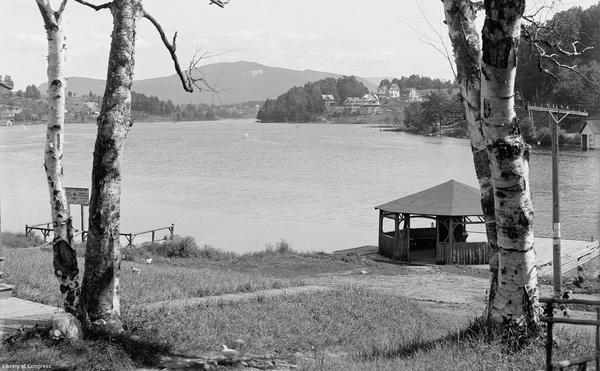 Lake Flower from River Street near the Colbath Cottage, 1902 Adirondack Daily Enterprise, Friday, August 29, 1986
Lake Flower from River Street near the Colbath Cottage, 1902 Adirondack Daily Enterprise, Friday, August 29, 1986
Pliny Miller comes to falls on Saranac River to build dam and set up his sawmill business
When Captain Pliny Miller arrived on the scene, back around 1822, the Saranac River coursed along calmly unimpeded between its natural banks until reaching a narrowing of the stream where it cascaded over a waterfall. This was just what he had been looking for. Miller was a veteran of the War of 1812 searching for a site suitable for development of a hydro-powered sawmill. Here he could build a dam, erect his mill and rely upon the surrounding wilderness forest to provide an unending source of logs.
Returning to his home at Sand Lake, just across the Hudson from Albany, he reported to his friend, Alric Bushnell, what he had discovered on the Saranac. The two men formed a partnership and purchased 300 acres, surrounding the site, from John R. Thurman a land speculator. Apparently Bushnell's enthusiasm fell considerably when he realized the extreme remoteness of the area. After all, there was only one other settler within 5 miles of the region in any direction. Who would they sell their product to? The intrepid Miller, however, had no such misgivings and firmly believed that once an industry was established a community was sure to follow He was so right.
Builds dam on river
Miller bought Bushnell's half interest and went to work. By 1827 he had his dam in place and while the reservoir was filling, he erected a saw mill. On some high ground overlooking the project he built his house. His dam was located just a few yards upstream from the present village dam and his mill stood on the same site as the presently vacant Paul Smith's office building. Nearby Maple Hill is where his long gone home was situated.
As the dam backed up the river's water, two distinct ponds were formed within the existing contours of the valley. Oddly the one adjacent to the dam was simply called the mill pond while the larger of the two, some 3 miles upstream, became known as Miller Pond. Down through this waterway the logs began to flow and the mill prospered. Just as the Captain had predicted, a bustling young community was building along the river. During the 1840's Miller built the first hotel in the place which was located where the village office building stands today. This infant hostelry served as a stepping stone for two men who were to become famous innkeepers in their own right.
 Lake Flower postcard, Courtesy of Noreen OslanderWilliam F. Martin leased the place in 1849 prior to moving on to his hotel on the Lower Lake which became one of the most popular resorts in the Adirondacks. After Martin's departure, Virgil C. Bartlett ran the hotel until 1854 when he, too, decided to move out on his own. He built his lodge on the outlet of Upper Saranac Lake and the place earned a niche in local history as the famous "Bartlett's Carry."
Lake Flower postcard, Courtesy of Noreen OslanderWilliam F. Martin leased the place in 1849 prior to moving on to his hotel on the Lower Lake which became one of the most popular resorts in the Adirondacks. After Martin's departure, Virgil C. Bartlett ran the hotel until 1854 when he, too, decided to move out on his own. He built his lodge on the outlet of Upper Saranac Lake and the place earned a niche in local history as the famous "Bartlett's Carry."
The hotel burns and is rebuilt
Miller's progeny expanded as rapidly as the settlement he founded. Three generations brought respected businessmen and office holders to serve the needs of an emerging village. After his death in 1859 his son, John J. inherited 80 acres of choice land from his father's estate. As the original hotel had burned, John built a new one on the site of the present band stand in Riverside Park. This hotel bordered on the mill pond and plays an important role in our drama.
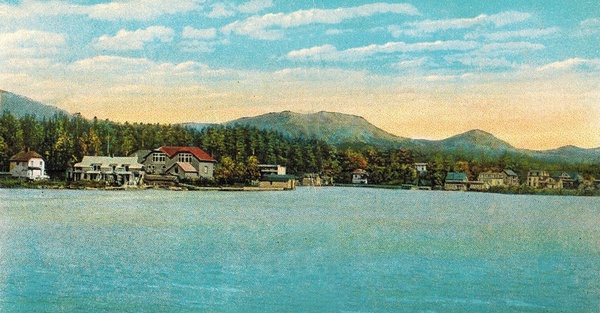 Lake Flower postcard, showing the Saranac Lake Boy's Club, left of center with the red roof.
Lake Flower postcard, showing the Saranac Lake Boy's Club, left of center with the red roof.
Courtesy of Noreen OslanderIn 1865 Miller sold out to Orlando Blood who enlarged the structure and brought a surge of prosperity to the establishment. He also incurred the wrath of the Reverend Lundy who wrote that the flourishing tavern made a "publican and sinner" the richest man in town. After Blood's tenure the hotel passed through other hands either by sale or lease.
Murder ends the lease
One such lease ended rather suddenly when the proprietor, George Berkeley, was shot by an irate barroom patron. After the murder, in 1888, a new owner took over and changed the name to the "Riverside Inn." Wallace Murray had been a guide and a lumberman before the transition to entrepreneur and boniface. "Wal," as he was popularly known, was well liked, a good businessman, and an excellent politician. He served two terms as Village President.
Once more the place was enlarged and surrounded by broad verandahs. Since his rooms and new porches overlooked the mill pond, Murray was concerned with the vista. Ever since the original flooding, pond was infested with a mess of ugly stumps which protruded above the water line and he intended to do something about it. Finally he hit upon a scheme which may have seemed presumptuous to some but not to the more optimistic Murray.
Governor comes to party
He planned a grand ball to be given at the Riverside in honor of the Governor. When all was ready he invited the Governor to attend and to everyone's surprise the Governor came. Perhaps because he was a north country resident he felt that he was obligated to put in his appearance. The ball was a huge success and the Riverside was filled to the rafters.
 Lake Flower, c. 1890, near the corner of River and Main Street. River Street runs between the wooden sidewalk and Lake Flower; stumps choke the area behind the logs. Adirondack Daily Enterprise, August 10, 1996
Lake Flower, c. 1890, near the corner of River and Main Street. River Street runs between the wooden sidewalk and Lake Flower; stumps choke the area behind the logs. Adirondack Daily Enterprise, August 10, 1996
After being duly wined and dined the Governor was approached by his host and a contingent of village fathers. Wouldn't it be nice, they suggested, if the state could come up with some funds to not only eliminate the navigational hazards but, at the same time, transform an ugly duckling into a swan lake. Such an accomplishment would surely reflect favorably on the administration of the Governor and insure a loyal following in the north country. How could he refuse?
Upon the Governor's return to Albany, the funds were soon made available, and an immediate contract was let to accomplish the project. As the last stump was extracted from the waterway a hallelujah celebration was held at the Riverside Inn. Wal Murray quickly assembled the village dignitaries and in solemn ceremony proclaimed that hence forth the mill pond would be officially known as "Lake Flower" in honor of Governor Roswell P. Flower of nearby Watertown. It has been Lake Flower ever since. 1
 Lake Flower Beach courtesy of Peter MacIntyre
Lake Flower Beach courtesy of Peter MacIntyre
Inane name changes
Miller Pond did not fare so well. During an inane period of local history when Indian names were being indiscriminately applied to places that never had known an aboriginal presence, Miller Pond was rechristened Oseetah Lake while neighboring Lonesome Pond became Lake Kiwassa. Despite the pseudo-legends put forth by real estate promoters to usurp pioneer nomenclature, a stubborn resistance has prevailed. To the senior citizens of Saranac Lake it will always be Miller Pond. Thankfully Lake Flower did not fall victim to a new baptism.
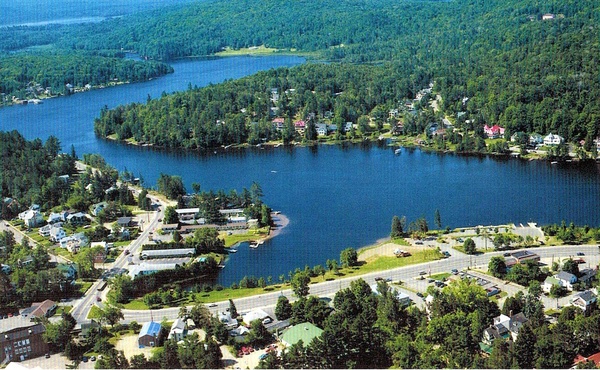 An aerial view of southern Lake Flower, looking south. River Street runs along the bottom of the photograph, turning up to become Lake Flower Avenue.
An aerial view of southern Lake Flower, looking south. River Street runs along the bottom of the photograph, turning up to become Lake Flower Avenue.
Postcard courtesy of Noreen OslanderAdirondack Daily Enterprise, March 21, 1983
Here's what happens to Lake Flower when the empoundment is released
The year was 1947 and the drinking toast of the summer was "Here's mud in your eye!" It was almost a vintage year for mud! Lake Flower and the scenic waterway up to the state locks was virtually a sea of mud.
Residents of Newman's Island looking upriver of a bright, sun-splashed morning were rewarded with an unbroken vista of stumps couched in an ooze so compelling that boots, rubbers and sneakers by the hundreds surrendered to the sucking action of the rancid plateau as boaters vainly tried to tug assorted crafts to camps and cottages.
This was truly a mud year and, though temporary, it was a nightmare that few villagers, camp owners and cottage dwellers would care to face again . . . especially on a permanent basis.
 Lake Flower from Blood Hill, c. 1920
Lake Flower from Blood Hill, c. 1920
Santway Photo-Craft Co., Inc., Watertown
Courtesy of the Adirondack Experience
Riparian rights had become a lively topic along Riverside Drive. The smell was euphoric in essence if you happened to be a pig or a turtle.
Past is past but past is also prologue as the poets say. The dam on Main Street is now the focal point of a minor revolution already festering and raising the hackles of the hard-nosed citizenry.
The question is currently "Which state agency has control of the Saranac Lake waterways system . . . the Department of Environmental Conservation or the Adirondack Park Agency?
The DEC's initial threat to breach the dam has become an academic irrelevancy.
Their previous assumption that the village was the owner of the dam has suffered several reverses and the village has served papers on the state to provide proof of such an assumption. The village now feels it has documentary proof that it is not the owner. The state disputes this in a story in today's Daily Enterprise.
The state refused to even consider an offer by the village to turn over the dam with exceptions in service, to the state which in no uncertain terms ruled vociferously, "WE don't want it now, later on or ever!"
When the state first threatened to wipe the dam out, they set a time limit for the village to complete a study and raise some up front money to initiate action. Eight weeks was the time frame allotment.
The spectre of a $50,000 shortfall of funds for dam repair left the Saranac Lake village board hanging on the ropes.
But God was in his heaven and the burden of proof quietly shifted to the state as to who actually had title to the dam. The state has admitted for the record that it can only deal with the owner.
The village cannot presume title and spend taxpayer money for an installation to which it has no deed or legitimate right to claim.
However, the village has pledged to participate in any and all efforts to preserve this historic dam and the extremely valuable lake that the dam impounds.
Not many at this point take seriously the state's threat to breach the dam which, in essence, constitutes a monument to Governor Roswell P. Flower who served the state in the late 1800's.
Behind the dam are miles of meandering streams, Oseetah Lake, many small islands, the state lock system, extensive private shoreline acreage, boat launching sites and limitless acres of waterfowl breeding marshes and wildlife habitat.
Since the area involved is truly a paradise, any threat to destroy the balance of nature would result in pitched battles. The rightful owner of the Lake Flower dam must be determined immediately if any kind of corrective action is to be undertaken this spring and summer.
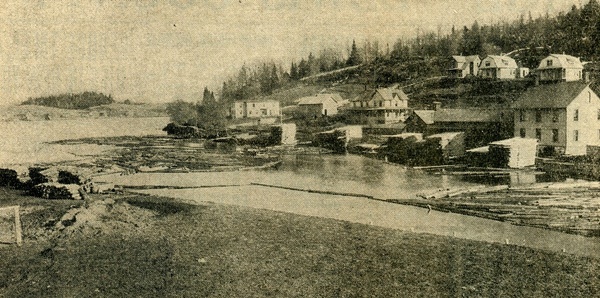 Watertown Daily Times, 1938 Watertown Daily Times, 1938 2
Watertown Daily Times, 1938 Watertown Daily Times, 1938 2
The above picture taken in 1895 shows Saranac Lake's Riverside Drive before it was developed into its present residential section. At that time, it was used for lumber drives down the Saranac river to the mills along Lake Champlain.
The log drive depicted here was one of the last through the Adirondack village. Shortly afterwards, an amendment to the state constitution, protecting the forests against devastation by lumbering was passed. Lumbering in the Adirondacks, as an industry, practically ceased.
Dr. G. W. Baldwin of Saranac Lake, took this picture.
Undated clipping, probably from the Adirondack Daily Enterprise, winter of 1930-31, Coogan scrapbooks
Lake Level at Lowest Stage in Many Years
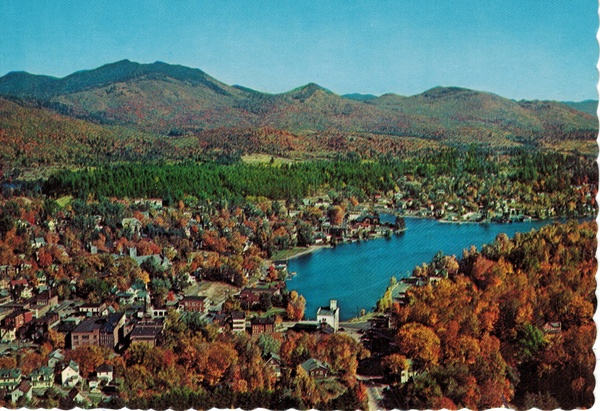 Post card Aerial shot of Lake Flower, Saranac Lake.
Post card Aerial shot of Lake Flower, Saranac Lake.
TCR 298
At its lowest stage since 1894 when the dam was rebuilt as part of the village waterworks system, Lake Flower’s level in the village this morning had reached a point six and one-half feet below the normal point.
Saturday night the water level had gone down so far that the village water pumps could not operate, and with power reservoirs down the Saranac river needing water desperately it was decided to permit the Paul Smith’s electric company to run water through at their mill-race here.
In return the power company is furnishing electric current free or cost for the operation of the electrically run centrifugal pump at the village power house. Over the weekend the water level has dropped rapidly as a result of this arrangement.
Superintendent William Demerse of the water bureau, a lifelong resident of this region, asserted that the water level is the lowest it has ever been in his memory except for the time the lake was drained to permit work on the dam.
He stated that a heavy thaw is needed immediately to make it possible to operate the water pumps as well as to keep the electric power plants further down the river in operation.
Advantage will be taken of the opportunity to make needed repairs to the flume leading to the village pumps, it was said.
Lake Placid News, May 15, 1914
Low Water Mark
The determination of the meaning of "low water mark" is the fundamental problem to be solved by the courts, according to Village Clerk Seaver A. Miller, in the legal contest pending between Captain E. E. Thomas and others on the shore front of Lake Flower in his vicinity. Mr. Miller is in possession of the original deeds conveying the property from Pliny Miller to John Jay Miller and from the latter to Arvilla Blood, sister of Orlando Blood. Pliny Miller, who was the first settler in this region after the Moodys, secured three hundred acres from John Thurman and others, who owned thousands of acres included in Great Tract No. 1 of Macomb's purchase. For a considerable time after the Legislature improved the frontage no taxes were paid on the land, which would seem to imply that it was public property. The question arises how any individual could transfer the public domain. The property was first assessed after Orlando Blood, who inherited 80 acres from his sister, left it to Wallace Murray. Low water mark was supposed to be the limit of the boundaries next to the stream or lake, of the eighty acres, but it has been constantly changing as the lake has been filled in. [Emphasis added on wiki.] Fred Colbath is one of the chief persons involved in the dispute with Thomas. Mr. Colbath says he has his deed direct from Orlando Blood, while that of Captain Thomas came only a few weeks ago from Mr. Murray.
W. R. Vosburg, proprietor of the Riverside garage, has had surveyors of Village Engineer Merrill at work lately determining his lines. Captain Thomas has had engineer Fraleigh and Mr. Colbath has also had surveys made. A compromise on Captain Thomas' part or a pretty legal fight seem to be the alternatives.
_____
Malone Gazette, February 2, 1894
Assemblyman Stevens, of Essex county, has introduced a bill appropriating $5,000 for continuing work in Saranac Lake and for removing obstructions from the same. A similar appropriation was granted last year and State Engineer Sehenck and his assistants accomplished excellent results with the money. If this second sum is voted the new State engineer will be enabled to go on with the work, which will add much to the healthfulness and attractiveness of Lake Flower and Saranac.
Comments
Footnotes
1. This account greatly simplifies a more complex tale. In 1892, Governor Flower vetoed a bill that would have allocated $20,000 for clearing the stumps from Lake Flower. In 1893, he signed a bill allocating $5,000 for clearing the stumps, and in 1894, an additional $4000 was allocated to finishing the job. Wallace Murray was awarded the $5000 contract for stump removal. Murray's obituaries say he was a great supporter of the Governor, and that he held a ball at the Riverside Inn in Flower's honor, after which Flower secured funding for the stump removal, and Murray subsequently arranged for the lake to be renamed. No year is assigned to this ball, and I am unable to locate an account of it in papers of the time.
2. For more information on this photograph and caption, see Old Saranac Lake photographs



